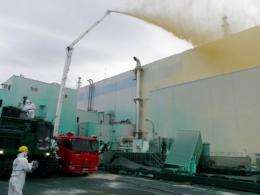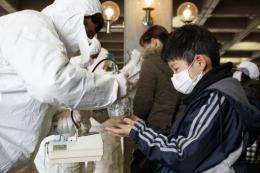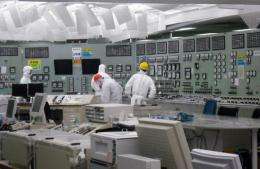Japan doubles plant radiation leak estimate

Japan has more than doubled its initial estimate of radiation released from the crippled Fukushima nuclear plant in the week after the March 11 tsunami, ahead of the launch of an official probe Tuesday.
The nation's watchdog, the Nuclear and Industrial Safety Agency (NISA), now says it believes 770,000 terabecquerels escaped into the atmosphere in the first week -- compared to its earlier estimate of 370,000 terabecquerels.
The findings were released on the eve of the first meeting Tuesday of an independent 10-member academic and expert panel that will look into the causes of the world's worst nuclear accident since Chernobyl a quarter-century ago.
The group's leader, a Tokyo University researcher on human error, Yotaro Hatamura, said at the meeting that "nuclear power has higher energy density and is dangerous. It was a mistake to consider it safe".
NISA's new figure is closer to that of Japan's independent Nuclear Safety Commission which had initially estimated a release at 630,000 terabecquerels in the first month.
The revision, almost three months after the quake, is likely to fuel criticism of the initially slow and vague flow of information from the government, and plant operator Tokyo Electric Power Company (TEPCO).

Japanese experts have stressed that most of the radiation released in the first days after the quake, amid a series of hydrogen explosions at the plant, was blown across the Pacific Ocean, not over inhabited areas.
Prime Minister Naoto Kan's special advisor on the nuclear crisis, Goshi Hosono, said Monday that the latest findings were unlikely to affect the TEPCO roadmap to bring all reactors to stable "cold shutdown" by October-January.
NISA also said in its review that it believes much of the nuclear fuel inside the three reactors melted down faster than previously believed after the tectonic disaster knocked out the plant's cooling systems.
The agency said melted fuel in unit one dropped to the bottom of the pressure vessel and damaged it some five hours after the quake hit the plant at 2:46 pm on March 11, followed by a 14-metre (46 foot) tsunami.

The agency said the same happened in unit two at about 10:50 p.m. on March 14, and that number three suffered damage at 10:10 p.m. on March 14.
TEPCO has said it believes the molten fuel is now being cooled by water at the bottom of the number one, two and three reactor pressure vessels, citing the relatively low outside temperatures of the containers.
Months of hosing operations have left over 100,000 tons of highly radioactive water in buildings, basements and tunnels at the plant, and TEPCO is struggling to remove the runoff so it can resume crucial repair work.
Contaminated water has spilled or been released several times into the Pacific Ocean, and environmental group Greenpeace has warned that it has found unsafe radiation levels in marine species as far as 50 kilometres offshore.
TEPCO has been testing water decontamination equipment, some provided by US and French companies, to remove radioactive substances, oil and seasalt from the runoff water so it can be reused as a reactor coolant from about mid-June.
With the advent of the summer rainy season in the region, they have also started to ship to the plant 370 truck-sized water tanks with a total capacity of more than 40,000 tons to store excess contaminated water.
(c) 2011 AFP

















